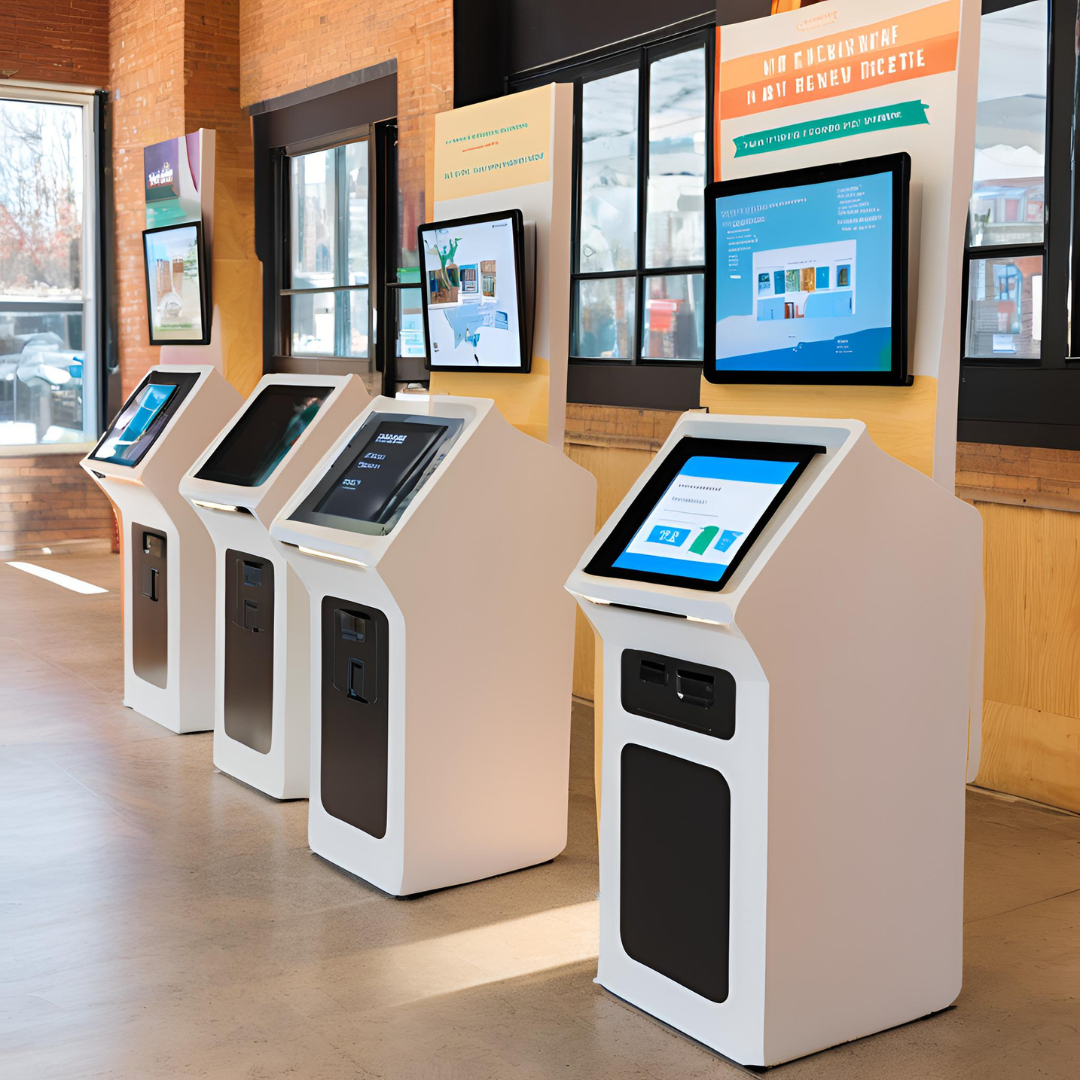Interactive Kiosks as Customer Engagement Tools: Strategies for Brand Promotion
"In today's digital age, the way we engage customers can set our brand apart from the rest." – Marketing Insights Journal
Introduction
Digital kiosks are revolutionising the retail landscape. These digital touchpoints offer businesses a dynamic way to engage customers, enhance experiences, and boost brand visibility. But what exactly makes them so effective for brand promotion? This post explores how interactive kiosks can transform customer engagement and offers strategies for leveraging them in your retail environment.

Table of Contents
-
The Rise of Interactive Kiosks
-
Understanding Customer Engagement
-
Why Interactive Kiosks?
-
Setting Up Your Kiosk
-
Design Matters
-
Content for Engagement
-
Location is Key
-
Integrating Data and Analytics
-
Best Practices for Kiosk Maintenance
-
Overcoming Challenges
-
Case Studies and Success Stories
-
The Future of Interactive Kiosks
-
FAQs About Interactive Kiosks
What is an Interactive Kiosk?
An interactive kiosk is a computer terminal that provides access to information and applications for communication, commerce, entertainment, or education. These self-service kiosks enable users to interact with the content through touchscreen technology or other interactive elements. By combining hardware and software, interactive kiosks facilitate a wide range of functionalities, making them a perfect solution for various industries. Whether it’s a retail space, a healthcare facility, or a government office, interactive kiosks can streamline operations and enhance user experiences.
The Rise of Interactive Kiosks
Interactive kiosks have become a staple in many retail settings. Early kiosks, like the one developed at the University of Illinois in 1977, were designed to assist users in accessing directories, including bus schedules, thereby demonstrating the kiosk's role in providing relevant information to users in public spaces. These self-service stations offer a variety of functions, from product browsing to checkout. Their popularity is driven by the growing consumer demand for quick and personalised shopping experiences.
-
Consumer Preferences: Shoppers increasingly seek convenience. Kiosks offer a streamlined way to access information and make purchases without waiting in line.
-
Technological Advances: Improved touchscreen technology and software solutions have made kiosks more user-friendly and efficient.
-
Cost Efficiency: Kiosks can reduce staffing needs, offering a cost-effective solution for busy retail environments.
Understanding Customer Engagement
Customer engagement is more than just interaction; it's about creating a meaningful connection between the consumer and the brand. Engaged customers are more likely to become repeat buyers and brand advocates.
-
Building Relationships: Effective engagement builds trust and loyalty, fostering long-term relationships with customers.
-
Personalised Experiences: Tailoring interactions to individual preferences enhances customer satisfaction and retention.
-
Feedback Loop: Engaged customers provide valuable feedback, helping brands improve products and services.
Why Self-Service Kiosks?
Interactive kiosks offer unique advantages as an interactive solution, providing customisable engagement tools tailored to the specific needs of various industries. They provide an immersive experience that captures customer attention and drives interaction.
Benefits of Interactive Kiosks
Interactive kiosks offer numerous benefits for businesses of any size. They increase efficiency and reduce operational costs by automating routine tasks, allowing staff to focus on personalised customer interactions. These kiosks improve the user experience by providing instant access to information and services, reducing wait times, and contributing to a smoother, more satisfying customer journey. Additionally, interactive kiosks enhance data collection and analysis by gathering valuable user information and preferences. This data helps businesses refine their marketing strategies and make informed decisions, ultimately driving growth and customer satisfaction.
Types of Interactive Kiosks
There are various types of interactive kiosks, each designed to meet specific needs and applications. Some common types include:
-
Payment Kiosks: Designed for bill payment, ticketing, and other financial transactions, these kiosks streamline the payment process and reduce the need for staff intervention.
-
Self-Service Kiosks: Used for tasks such as wayfinding, information retrieval, and product ordering, these kiosks empower customers to find what they need quickly and efficiently.
-
Digital Signage Kiosks: Utilised for advertising, marketing, and communication, these kiosks display dynamic content to capture customer attention and convey important messages.
-
Branded Kiosks: Customised to meet the specific needs and branding of a particular business or organisation, these kiosks reinforce brand identity while providing valuable services.
Setting Up Your Kiosk
Successfully deploying a kiosk involves careful planning and execution. Businesses should consider several factors to ensure their kiosks are effective.
-
Objectives and Goals: Define what you want to achieve with your kiosk, whether it's increasing sales, enhancing customer service, or collecting data.
-
Kiosk Type: Choose the right type of kiosk for your needs, such as informational, transactional, or promotional.
-
Installation: Ensure professional installation for optimal performance and security.
Design Matters for Digital Signage
The design of your kiosk plays a crucial role in attracting and retaining customer attention. A well-designed kiosk is intuitive and visually appealing.
-
User Interface: Keep the interface simple and easy to navigate, with clear instructions and prompts.
-
Aesthetic Appeal: Use colours, images, and branding elements that align with your brand identity.
-
Accessibility: Ensure the kiosk is accessible to all users, including those with disabilities.
Content for Engagement
Content is king, even for kiosks. Dynamic and relevant content keeps customers engaged and interested.
-
Product Information: Provide detailed information about products, including features, benefits, and pricing.
-
Promotions and Offers: Highlight special promotions, discounts, and loyalty programmes to entice customers.
-
Interactive Elements: Incorporate videos, games, and quizzes to make the experience more engaging and fun.
Location is Key
The location of your kiosk can significantly impact its success. Strategic placement enhances visibility and accessibility.
-
High-Traffic Areas: Place kiosks in areas with high footfall, such as entrances or near popular products.
-
Visibility: Ensure the kiosk stands out and is easily visible to passersby.
-
Convenience: Position kiosks where customers are likely to need information or assistance.
Interactive kiosks can incorporate a building directory and wayfinding solution to assist visitors in navigating within facilities.
Industry Applications of Interactive Kiosks
Interactive kiosks are widely used across various industries, each leveraging the technology to meet unique needs:
-
Retail: Kiosks provide product information, enable self-service, and enhance the shopping experience by offering personalized recommendations and promotions.
-
Hospitality: In hotels and resorts, kiosks offer wayfinding solutions, information, and services to guests, improving their overall experience.
-
Healthcare: Kiosks streamline administrative tasks, provide patient information, and enable self-service check-ins, reducing wait times and improving efficiency.
-
Education: Schools and universities use kiosks to provide access to educational resources, enable self-service for administrative tasks, and enhance the learning experience.
-
Government: Kiosks in government offices provide information, enable self-service for various applications, and streamline administrative processes, making services more accessible to the public.
Integrating Data and Analytics
Data collected from kiosks can provide valuable insights into customer behaviour and preferences. This data can inform marketing and operational strategies.
-
Customer Insights: Analyse data to understand customer demographics, interests, and buying patterns.
-
Performance Metrics: Track kiosk usage, engagement rates, and conversion rates to assess effectiveness.
-
Continuous Improvement: Use insights to refine kiosk content, design, and placement for better results.
Measuring the Success of Interactive Kiosks
To measure the success of interactive kiosks, businesses can track various metrics, including:
-
User Engagement: Monitor the number of users, session length, and interaction time to gauge how effectively the kiosk captures and retains attention.
-
Transaction Volume: Track the number of transactions completed through the kiosk to assess its impact on sales and service efficiency.
-
Customer Satisfaction: Use surveys, feedback forms, and Net Promoter Score (NPS) to gather insights into user satisfaction and identify areas for improvement.
-
Return on Investment (ROI): Compare the revenue generated by the kiosk to the cost of implementation and maintenance to determine its financial viability.
By tracking these metrics, businesses can evaluate the effectiveness of their interactive kiosks and make data-driven decisions to optimise performance and enhance the user experience.
Best Practices for Kiosk Maintenance
Regular maintenance ensures kiosks remain functional and reliable. This helps prevent downtime and enhances customer satisfaction.
-
Routine Checks: Conduct regular inspections to identify and address any issues promptly.
-
Software Updates: Keep software updated to protect against security vulnerabilities and enhance functionality.
-
Cleaning and Upkeep: Maintain cleanliness to ensure a pleasant user experience and extend the kiosk's lifespan.
Overcoming Challenges
Implementing kiosks comes with challenges, such as technical issues and user resistance. Addressing these challenges is crucial for success.
-
Technical Support: Provide on-demand technical support to quickly resolve issues and minimise disruptions.
-
User Training: Educate staff and customers on how to use the kiosks effectively.
-
Feedback Mechanisms: Encourage users to provide feedback on their kiosk experience to identify areas for improvement.
Case Studies and Success Stories
Learning from others can provide valuable insights. Explore how other businesses have successfully integrated kiosks.
-
Retail Giants: Many large retailers have seen increased sales and customer satisfaction through kiosk deployment.
-
Small Businesses: Even small businesses have benefited from kiosks, enhancing customer service and reducing costs.
-
Innovative Uses: Discover how businesses creatively use kiosks for promotions, surveys, and entertainment.
The Future of Interactive Kiosks
The future of kiosks is bright, with advancements in AI and IoT offering new possibilities. Staying ahead of trends keeps your business competitive.
-
AI Integration: Artificial intelligence can personalise interactions further, offering tailored recommendations.
-
IoT Connectivity: Connected kiosks can provide real-time updates and integrate with other digital platforms.
-
Sustainability: Eco-friendly kiosks using renewable energy sources are gaining popularity.
FAQs About Interactive Kiosks
Q1: Are interactive kiosks expensive to implement?
A1: Costs vary based on features and installation, but kiosks often provide a strong return on investment through increased sales and reduced staffing needs.
Q2: How do I measure the success of my kiosk?
A2: Use metrics like engagement rates, conversion rates, and customer feedback to assess effectiveness and make improvements.
Q3: Can kiosks be customised for my brand?
A3: Yes, kiosks can be tailored to match your brand identity with custom designs, colours, and content.
Conclusion
Interactive kiosks offer a powerful tool for retail businesses and marketers seeking to enhance customer engagement and brand promotion. By carefully planning and executing kiosk deployment, businesses can create memorable experiences that drive engagement and foster brand loyalty. For those ready to explore this innovative approach, the next step is to consider your objectives, design a compelling kiosk experience, and continually refine your strategy to meet evolving customer needs.

